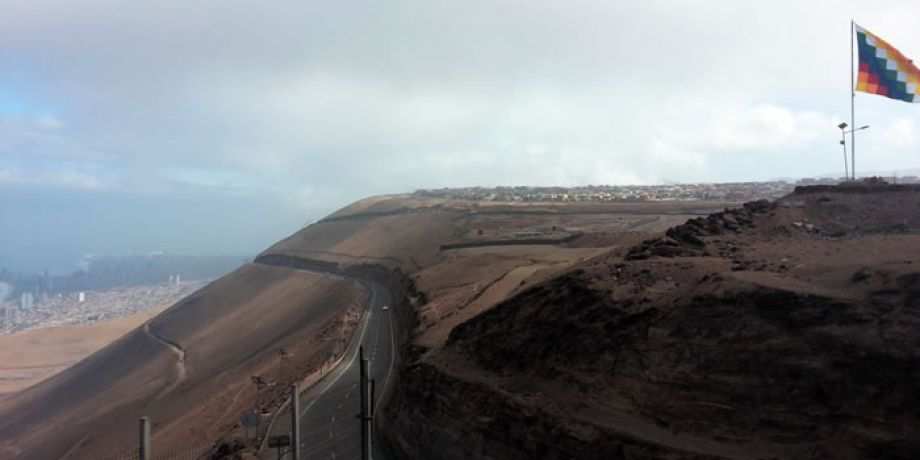
Korean Priests in Chile
On a September morning in 2014, I arrived in Iquique in northern Chile on a flight from Santiago. I was coming to visit the Korean Associates who work with the Columbans in a parish in the new city of Alto Hospicio which has formed in the hills above Iquique. It has grown from a small town of about 2,000 inhabitants in the early 1990s to a huge city today with over 100,000 inhabitants.
At the airport I was met by Fr. Casmir Sung Woo-jin, a Korean associate priest working in Alto Hospicio. His companions are Fr. Albinus Lee Chun-hyung, also an associate from Korea, and Fr. Michael Howe, a Columban from Ireland, with whom I had studied in Navan. They were all working together in the parish of Sacred Heart of Jesus. As we drove in towards Iquique and then turned up the hill to Alto Hospicio the dominant feature was the sand, the desert and the absence of any green vegetation. We were on the coastal line of the Atacama Desert, the driest place on earth. Alto Hospicio is just over six miles outside of Iquique and just under one half mile above sea level.
The Columbans have worked in Iquique since the 1970s, and they moved up to Alto Hospicio in the 1990s. Over the years they have established three parishes in the city. Local church personnel now run two of the parishes, and the Columbans staff the parish of the Sacred Heart. The house where the three Columbans live is simple as was the fare. They accompany the people in their lives. Fr. Albinus recalled the earthquake of April 1, 2014, when an earthquake measuring 8.2 on the Richter scale struck the city of Iquique at evening time. Several apartments were severely damaged, so the Columbans opened up one of the chapels as a temporary center.
The majority of the people have come from the interior which was originally evangelized by the Spanish Friars who came down from Cusco in Peru. The friars visited only a few times a year, so the faith did not develop around the parish structure with regular Masses and education programs. Rather it is centered on devotion to saints, and shrines are everywhere. There is very low participation at Mass.
For Frs. Albinus and Casmir fresh from working in a very different model of Church in Korea this is a huge challenge. In Korea there are big attendances at parish Masses, and the liturgies are very participative – diametrically opposite to the present reality in Alto Hospicio. Fr. Albinus shared his struggle to recognize and accept those differences, and he was very aware of the temptation of believing that his own cultural experience of Church is the only one.
In particular in July when the people leave on pilgrimage to the visit the Marian Shrine of Tirana in the desert, no one comes for the Mass! So we took a trip through the desert to visit the shrine. This is an area rich in metallic resources including copper, gold, silver and iron as well as non-metallic minerals like lithium, sodium nitrate and potassium salts. Mining of course was the catalyst for opening up the area. It brought in explorers, entrepreneurs, and of course people came to work in the mines. But it also opened up a new chapter of suffering and violence as workers were exploited in the mines. Fr. Casmir told me of the massacre of 1,000 miners by the police who were demanding better conditions back in 1901. Earlier in the 19th century war erupted between Chile on one side and Peru and Bolivia on the other over these resources–the Pacific War of the Atacama Border Dispute. Today the desert is littered with abandoned nitrate mining towns, almost all of which shut down decades after the invention of synthetic nitrate at the turn of the 20th century.
Life is harsh in the desert, and the devotion of the people to saints reflects the lives of the people, their history of suffering and struggle in a harsh environment. Everywhere Jesus is depicted with suffering features. In the famous Marian Shrine of Tirana, Mary is seen as a mother standing with and protecting working miners. Very often all the images are pictured wrapped in the Chilean flag. The challenge now is to give depth and reinterpret the tradition so that it nurtures a faith which can help people in their lives today.
In many ways the Korean missionaries come from a background which gifts them, enables them to respond to these needs of the people here. The majority of the Korean martyrs, beatified by Pope Francis during his visit to Korea in 2014, come from Jeonju and Daejeon, the home dioceses of Frs. Albinus and Casmir respectively. The faith in Korea is one which grew in the cauldron of persecution for the first 100 years of the Church, later in the struggle for liberation against Japan and more recently the struggle for democracy at the end of the 20th century. It is an experience of Jesus the liberator, the one who walks with the poor in their daily struggles, the one who cares for the suffering. Sharing this experience of Jesus the liberator, can indeed be a great gift to the people of Alto Hospicio.
Columban Fr. Donal O’Keefe lives and works in Seoul, South Korea.